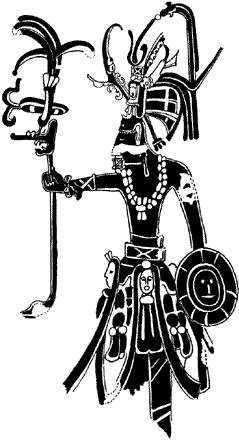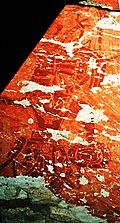
| 1997 1998 1999 2000 2001 Hilites | The Temple XX Frescoed Tomb |

|

|
THE TOMB VIDEO
|
To date no human being since ancient Maya times has entered the tomb under
Palenque's Temple XX. But in May of this year a Project film crew
composed of David Pentecost, Alonso Mendez, and Alfonso
Morales managed to lower a video camera through the small hole into the
tomb. The hole, in the upper northeast corner, is just large enough to
permit the introduction of the compact digital video camera.
The camera was lowered at the end of a pole, attached by a harness and a cable with a nylon cord for guidance and security. The filming was accomplished by David manipulating the camera on the end of the pole. The camera was connected to a video monitor outside the tomb by means of a cable, which made it possible to guide its movements. Light was provided by an incandesent light bulb hanging from the hole. A 115-volt gasoline generator powered the system. The filming was done in several short sessions so that the lightbulb would not adversely affect the interior of the tomb. During the video documentation, the interior temperature and humidity were closely monitored. The videotape, of which we present a short segment, serves as a vital document of the appearance of the tomb's interior before it is opened. Before now it has not been shown to the media or the public. In the first scene you will see some of our Tzeltal Maya workers at the top of the shaft by which the exerior corner of the tomb is currently accessed through a steel security door. After an on-camera appearance by David Pentecost (with the sound of the electric generator in the background), the camera pans quickly past the nylon cable which served as the camera's "umbilical cord" inside the tomb, and there is a fleeting glimpse of the access hole. On the floor of the tomb you will see ceramics and jade beads, and on the walls the remarkably preserved frescoes. The musical score by Al Owens recreates some of the actual sounds of the ancient Maya with such exotic but authentic instruments as turtle shells. The work of the Palenque Project is sponsored by the Center for the History of Ancient American Art and Cultures (CHAAAC) under the directorship of Professor Nikolai Grube of the University of Texas at Austin. A special application was used to freeze frames of the video for a clearer look and a faster download. This work was carried out by Daniel Haworth and Joel Skidmore, with editing by Michael Cavanaugh. To view the video Quicktime version 4 or higher is recommended. |
|
|
top
